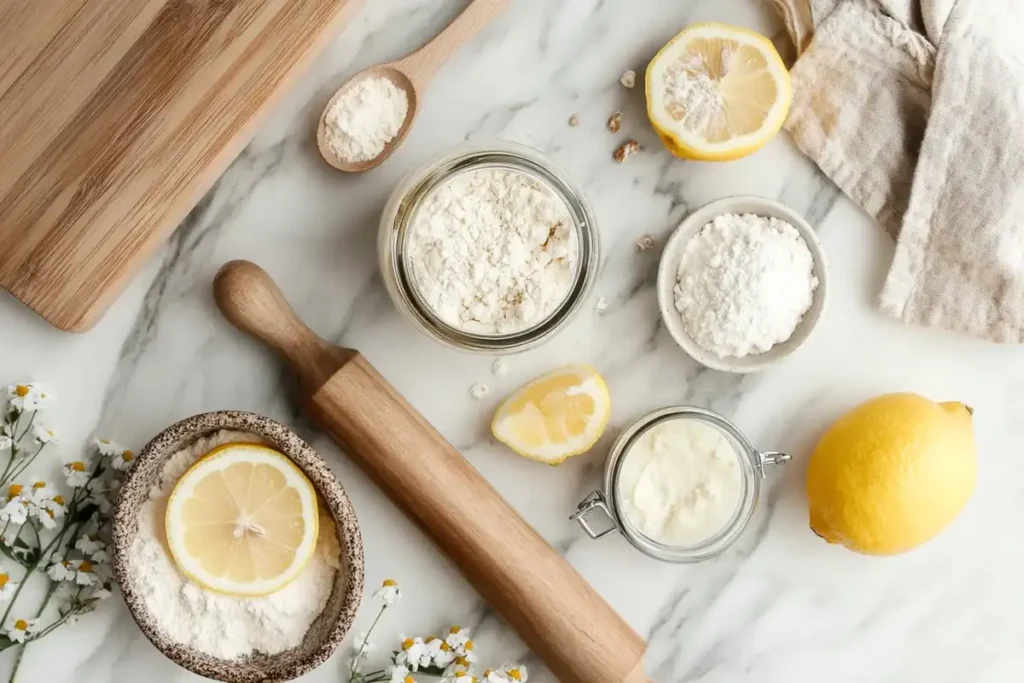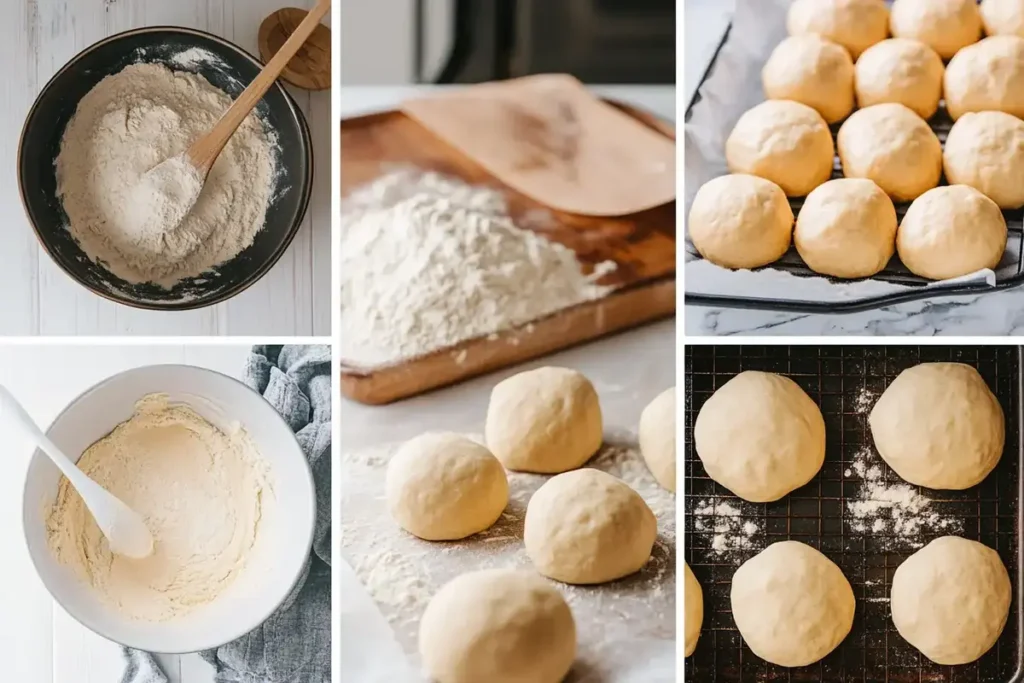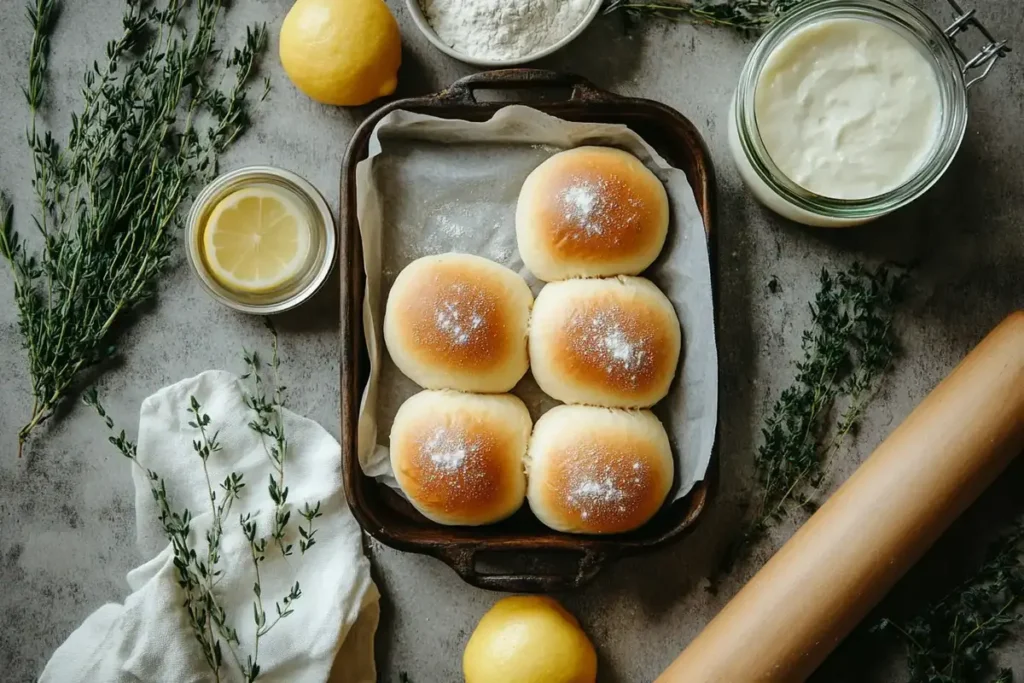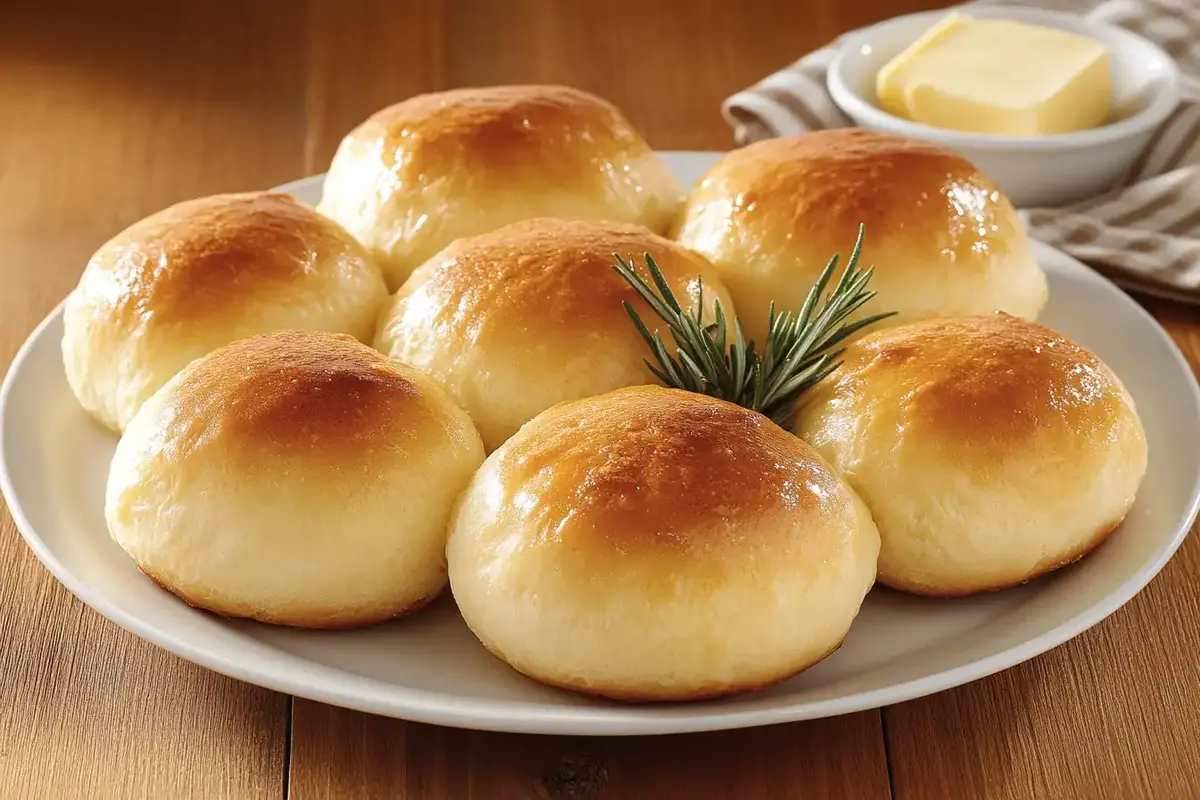Baking dinner rolls without yeast can seem daunting at first, but it’s easier than you might think! Whether you’re dealing with a yeast shortage, accommodating dietary restrictions, or just seeking a quicker baking solution, there are plenty of fantastic alternatives to traditional yeast. This guide dives into everything you need to know about substituting yeast in dinner rolls, from understanding its role in baking to exploring creative, yeast-free recipes. Let’s roll into Part 1!
What Is a Substitute for Yeast in Dinner Rolls?
Dinner rolls owe much of their light and fluffy texture to yeast. It acts as a leavening agent, helping the dough rise and creating air pockets that make the rolls so irresistibly soft. But what if you don’t have yeast on hand? Fear not—there are practical and effective substitutes to achieve similar results.
Understanding Yeast in Baking
Yeast is a living organism that ferments sugars in the dough. During fermentation, it produces carbon dioxide, which gets trapped in the gluten network, causing the dough to expand. This is how yeast gives bread its airy structure and slightly tangy flavor. But here’s the good news: other leavening agents can mimic this effect, even if they don’t perfectly replicate the flavor.
Why Substitute Yeast?
Sometimes, you might find yourself without yeast. Or perhaps you’re avoiding it due to an allergy or personal preference. Either way, finding the right yeast alternative for dinner rolls ensures that you can still bake delicious rolls without compromise. Plus, these substitutes often speed up the process, as many require less rising time than traditional yeast.
The Benefits of No-Yeast Dinner Rolls
Substituting yeast doesn’t just open doors to experimentation—it also simplifies the baking process. Most alternatives, like baking powder or baking soda paired with acidic ingredients, are pantry staples. They eliminate the need for hours of proofing, so you can enjoy freshly baked rolls in a fraction of the time.
Understanding Yeast and Its Role in Baking
The Function of Yeast in Dinner Rolls
Yeast is more than just a leavening agent—it’s the secret to creating those soft, pillowy dinner rolls that everyone loves. As a living microorganism, yeast feeds on sugars in the dough through a process called fermentation. During this process, it produces carbon dioxide and ethanol. While the ethanol largely evaporates during baking, the carbon dioxide remains trapped in the dough, forming tiny bubbles that expand and cause the dough to rise.
This rising action is what gives dinner rolls their characteristic airy texture. Moreover, yeast contributes to the flavor profile of the rolls, adding subtle tangy and nutty notes that make them so delectable. However, using yeast also requires patience, as it often takes hours for the dough to properly rise. But, what if you can’t use yeast? That’s where clever substitutes come in, each offering its own unique twist to the baking process.
Reasons to Substitute Yeast
Why might you need to find a substitute for yeast in dinner rolls? Let’s explore a few common reasons:
- Allergies and Sensitivities
Some individuals are sensitive or allergic to yeast, experiencing adverse reactions when consuming it. For such cases, substituting yeast becomes necessary to enjoy freshly baked rolls without compromising health. - Supply Shortages
Occasionally, yeast can be hard to find—think of the baking craze during the pandemic! If your pantry is out of yeast, don’t let that stop you from making dinner rolls. There are plenty of alternatives to fall back on, such as baking powder or sourdough starter. - Dietary Preferences
Certain diets, like those following strict natural food principles, may avoid commercial yeast altogether. In such cases, natural leavening options like sourdough starter can be an excellent choice. Additionally, yeast-free rolls can align with specific low-yeast or yeast-free diet plans.
Common Yeast Substitutes in Baking
Baking Powder as a Leavening Agent
When it comes to quick and convenient yeast substitutes, baking powder often tops the list. As a leavening agent, baking powder contains a blend of an acid (such as cream of tartar) and a base (usually sodium bicarbonate). When moistened and heated, these components react to release carbon dioxide gas, causing dough to rise.
Using baking powder in dinner rolls eliminates the need for long proofing times. Instead, the leavening action occurs almost immediately when the dough is mixed and continues in the oven. However, there is a catch: rolls made with baking powder may have a slightly denser texture compared to those made with yeast. That said, they’re still delicious, and the subtle change in texture can be offset with flavorful additions like herbs or cheese.
A simple ratio to substitute yeast with baking powder is to use 1 teaspoon of baking powder for every cup of flour in your recipe. For best results, work quickly after mixing, as the leavening process begins as soon as moisture activates the baking powder.
Baking Soda Combined with Acidic Ingredients
Another effective substitute is baking soda paired with an acidic ingredient like lemon juice, vinegar, or buttermilk. This combination creates a chemical reaction that produces carbon dioxide bubbles, giving your dough the lift it needs.
The key here is balance. Since baking soda is much stronger than baking powder, it’s critical to pair it with just the right amount of acid to avoid a metallic aftertaste. For every 1 teaspoon of baking soda, use about 1 tablespoon of an acidic liquid. This substitute is perfect for creating no-yeast dinner rolls in a pinch.
One advantage of this method is its flexibility. You can choose different acidic ingredients depending on the flavor profile you’re aiming for. For instance, buttermilk adds a creamy tang, while vinegar lends a sharp bite.

Sourdough Starter as a Natural Leavening Agent
If you’re looking for a more traditional yet yeast-free option, a sourdough starter is an excellent choice. This fermented mixture of flour and water naturally captures wild yeast and lactobacilli from the environment. Over time, the starter develops a robust flavor and the ability to leaven dough, making it a perfect substitute for commercial yeast.
Using a sourdough starter requires a bit more preparation, as it needs regular feeding (adding fresh flour and water) to remain active. However, the results are worth the effort. Rolls made with sourdough starter have a complex, tangy flavor and a slightly chewy texture, reminiscent of artisanal bread.
To replace yeast with sourdough starter, use about 1 cup of active starter for every 2 cups of flour in your recipe, adjusting the liquid accordingly. While it’s not as quick as baking powder or soda, sourdough’s depth of flavor makes it a favorite among seasoned bakers.
Recipes for No-Yeast Dinner Rolls
Quick No-Yeast Dinner Rolls Recipe
If you’re craving warm, fluffy dinner rolls but don’t have any yeast on hand, this quick recipe is your go-to solution. By using baking powder as the leavening agent, you can whip up a batch of soft, delicious rolls in under an hour. The texture is a delightful blend between traditional dinner rolls and buttery biscuits—perfect for any meal!
Ingredients:
- 2 cups all-purpose flour
- 1 tablespoon baking powder
- 1 teaspoon salt
- 2 tablespoons granulated sugar
- 1/4 cup unsalted butter (melted)
- 3/4 cup milk
Instructions:
- Preheat Your Oven
Set your oven to 375°F (190°C) and line a baking sheet with parchment paper. - Mix Dry Ingredients
In a large bowl, whisk together the flour, baking powder, salt, and sugar. - Incorporate Wet Ingredients
Add the melted butter and milk to the dry mixture. Stir until a sticky dough forms, but don’t overmix. - Shape the Rolls
Use your hands to divide the dough into 8 equal portions. Roll them gently into balls and place them on the prepared baking sheet. - Bake to Perfection
Bake the rolls for 15–20 minutes or until they turn golden brown on top. Let them cool slightly before serving.

Sourdough Dinner Rolls Recipe
For those with a sourdough starter in their arsenal, this recipe delivers dinner rolls with a rich, tangy flavor and a chewy texture. While it requires a little extra preparation time, the results are worth every minute!
Ingredients:
- 1 cup active sourdough starter
- 2 cups all-purpose flour
- 1/2 cup warm water
- 2 tablespoons olive oil
- 1 tablespoon honey
- 1 teaspoon salt
Instructions:
- Activate the Starter
Make sure your sourdough starter is bubbly and active before starting. Feed it 4–6 hours before using for best results. - Combine Ingredients
In a mixing bowl, combine the starter, flour, warm water, olive oil, honey, and salt. Mix until a soft dough forms. - Knead and Rest
Knead the dough for 8–10 minutes until smooth. Cover the bowl with a damp towel and let it rest for 4–6 hours or until it doubles in size. - Shape the Rolls
Divide the dough into 8–10 pieces and shape each into a ball. Place them on a greased baking dish, leaving a little space between each. - Second Rise and Bake
Allow the rolls to rise for another 2 hours. Preheat the oven to 375°F (190°C) and bake for 20–25 minutes or until golden brown.

Tips for Successful No-Yeast Baking
Adjusting Liquid Ratios
When swapping yeast for other leavening agents, nailing the liquid-to-dry ingredient ratio is crucial. Unlike yeast-based doughs, which rely on long hydration times for gluten development, no-yeast doughs require a slightly different approach. Too much liquid can lead to overly sticky dough that’s difficult to handle, while too little can result in dry, crumbly rolls.
For instance, if using sourdough starter, reduce the water in your recipe to account for the liquid in the starter itself. Similarly, if you’re working with baking powder or soda, you may need to adjust the amount of milk or buttermilk to achieve a smooth, cohesive dough. Always aim for a soft, pliable texture that doesn’t stick excessively to your hands.
Flavor Considerations
One of the main differences between yeast-leavened and no-yeast rolls is flavor. Yeast imparts a subtle tang and depth that’s hard to replicate. To enhance the taste of your no-yeast rolls, try incorporating bold flavors into the dough.
Here are some ideas:
- Herbs: Add dried rosemary, thyme, or oregano for a savory touch.
- Garlic and Cheese: Minced garlic and grated cheddar or parmesan can elevate your rolls.
- Sweet Additions: If you prefer sweet rolls, mix in cinnamon, nutmeg, or even a swirl of honey.
Flavor enhancers not only compensate for the absence of yeast but also give your rolls a unique and delicious twist. Experiment with your favorite combinations to make them truly yours.
Frequently Asked Questions
Can I Use Self-Rising Flour Instead of Yeast?
Yes, self-rising flour can be a convenient alternative to yeast when baking dinner rolls. Self-rising flour contains both baking powder and salt, making it a ready-to-use leavening option. By eliminating the need for additional leavening agents, it simplifies the recipe.
However, dinner rolls made with self-rising flour will have a slightly different texture and flavor than those made with yeast. They may be denser and less airy, leaning closer to a biscuit-like consistency. To use self-rising flour, simply replace the all-purpose flour and baking powder in your recipe with equal amounts of self-rising flour.
What Is the Difference Between Baking Powder and Yeast?
While both baking powder and yeast are leavening agents, they work in entirely different ways.
- Yeast is a living organism that ferments sugars in the dough, producing carbon dioxide gas over time. This slow process gives bread its distinct flavor and airy texture.
- Baking powder, on the other hand, is a chemical leavening agent. It reacts immediately upon contact with moisture and heat, releasing carbon dioxide through an acid-base reaction.
The key distinction lies in the flavor and texture. Rolls made with yeast have a more complex flavor and a chewy crumb, while those with baking powder tend to be lighter but denser in flavor complexity.
How Does Sourdough Starter Replace Yeast?
A sourdough starter acts as a natural leavening agent, replacing commercial yeast in recipes. Made from fermented flour and water, it contains wild yeast and beneficial bacteria. These microorganisms work together to ferment the dough, producing carbon dioxide and lactic acid.
To replace yeast with sourdough starter in dinner rolls, use about 1 cup of active starter for every 2 cups of flour. Adjust the liquid in your recipe to account for the water content in the starter. While the preparation takes longer, sourdough adds a tangy, rich flavor that’s hard to beat.
Are No-Yeast Dinner Rolls Denser Than Yeast Rolls?
Yes, rolls made without yeast are typically denser. Yeast creates a gluten structure that traps air bubbles, leading to a light, fluffy texture. Substitutes like baking powder or soda don’t replicate this elasticity, resulting in a different crumb structure.
That said, no-yeast dinner rolls can still be soft and delicious. By adjusting your recipe and adding flavor enhancers, you can achieve a satisfying texture that rivals traditional yeast-based rolls.
Can I Make Gluten-Free No-Yeast Dinner Rolls?
Absolutely! Gluten-free no-yeast dinner rolls are achievable with the right ingredients. Substitute all-purpose flour with a gluten-free flour blend and use leavening agents like baking powder or baking soda with an acid.
Keep in mind that gluten-free doughs are less elastic, so the texture may differ. Adding binding agents like xanthan gum or psyllium husk can help improve the structure of your rolls. Experiment with flavors to make them just as delightful as their gluten-containing counterparts.
What Are Some Flavor Variations for No-Yeast Dinner Rolls?
Elevate your no-yeast rolls with creative flavor twists! Consider these ideas:
- Savory Additions: Mix in garlic powder, shredded cheese, or dried herbs like rosemary and thyme.
- Sweet Options: Swirl in cinnamon and sugar, or add a drizzle of honey for a sweet touch.
- Seasoned Toppings: Sprinkle sesame seeds, poppy seeds, or coarse sea salt on top before baking.
These simple additions can transform your rolls from basic to extraordinary.
Conclusion
Enjoying Dinner Rolls Without Yeast
Yeast may be the traditional choice for leavening, but as we’ve seen, there are plenty of effective substitutes to keep you baking no matter the circumstance. Whether you opt for quick solutions like baking powder or more artisanal methods like sourdough, you can enjoy warm, delicious dinner rolls without yeast.
Experiment with these alternatives, and don’t shy away from adding your personal touch with flavors and textures. Baking is as much about creativity as it is about tradition, so embrace the freedom to innovate and enjoy every bite!

